人教版必修五Unit3 教学设计与反思
- 格式:doc
- 大小:59.00 KB
- 文档页数:5

人教版高中英语必修五M5U3 Reading教学设计与反思作者:叶芳来源:《中学教学参考·语英版》2016年第11期[摘要]“翻转课堂”教学模式,即先学后教,以学定教,改变了目前高中英语课堂教师一味灌输、学生被动接受的教学现状,真正将参与课堂互动的主动权交还给学生。
人教版高中英语必修五M5U3 Reading的教学就可以采用“翻转课堂”的教学模式,培养学生自主学习的习惯。
[关键词]教学设计翻转课堂导学案自主学习[中图分类号] G633.41[文献标识码] A[文章编号] 16746058(2016)310053一、教材分析(一)教材的地位和作用教学内容为人教版高中英语必修五Module 5 Unit 3 Life in the future的Reading部分。
本单元的中心话题是“未来生活”,教材内容为学生提供了想象的空间,也激发了学生的学习热情,学生们带着极大的兴趣走进了这单元的学习。
这是本单元的第二课时。
在第一课时中,笔者对教材进行了整合,完成了Warming-up,Listening in the workbook以及Speaking的内容。
本篇Reading“First Impressions”是一封电子邮件,文章主要讲述主人公Li Qiang乘坐时间胶囊来到公元3008年的见闻,着重介绍了未来的环境、交通和房屋三方面内容。
通过学习,学生们能够受到启发而畅想未来,关注未来,意识到要适应社会发展就必须努力学习,用知识武装自己,这样才能创造更加美好的未来。
(二)教学目标1.知识目标。
①帮助学生理解、掌握、运用如下词汇:impress, constant, previous, lack,optimistic, tablet, opening, aspect, surroundings, capsule, uncertain, take up, tolerate,sweep up, lose sight of, remind sb of sth, suffer from, slide into,be back on one’s feet.②学生能够通过本课的学习对未来展开想象,并对未来生活进行一定预测,在预测中尝试使用有关表示预测的功能结构,如:It is likely/unlikely that...; It is possible that...;I’m sure...;It’s certain that...; I wonder if...; I imagine that...; Suppose that...;Perhaps/Maybe/Possibly/Probably/Most likely...等。
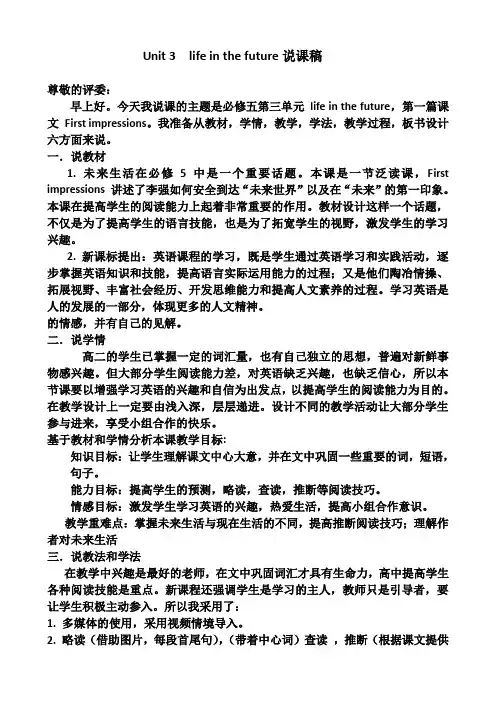
Unit 3 life in the future说课稿尊敬的评委:早上好。
今天我说课的主题是必修五第三单元life in the future,第一篇课文First impressions。
我准备从教材,学情,教学,学法,教学过程,板书设计六方面来说。
一.说教材1. 未来生活在必修5中是一个重要话题。
本课是一节泛读课,First impressions 讲述了李强如何安全到达“未来世界”以及在“未来”的第一印象。
本课在提高学生的阅读能力上起着非常重要的作用。
教材设计这样一个话题,不仅是为了提高学生的语言技能,也是为了拓宽学生的视野,激发学生的学习兴趣。
2. 新课标提出:英语课程的学习,既是学生通过英语学习和实践活动,逐步掌握英语知识和技能,提高语言实际运用能力的过程;又是他们陶冶情操、拓展视野、丰富社会经历、开发思维能力和提高人文素养的过程。
学习英语是人的发展的一部分,体现更多的人文精神。
的情感,并有自己的见解。
二.说学情高二的学生已掌握一定的词汇量,也有自己独立的思想,普遍对新鲜事物感兴趣。
但大部分学生阅读能力差,对英语缺乏兴趣,也缺乏信心,所以本节课要以增强学习英语的兴趣和自信为出发点,以提高学生的阅读能力为目的。
在教学设计上一定要由浅入深,层层递进。
设计不同的教学活动让大部分学生参与进来,享受小组合作的快乐。
基于教材和学情分析本课教学目标:知识目标:让学生理解课文中心大意,并在文中巩固一些重要的词,短语,句子。
能力目标:提高学生的预测,略读,查读,推断等阅读技巧。
情感目标:激发学生学习英语的兴趣,热爱生活,提高小组合作意识。
教学重难点:掌握未来生活与现在生活的不同,提高推断阅读技巧;理解作者对未来生活三.说教法和学法在教学中兴趣是最好的老师,在文中巩固词汇才具有生命力,高中提高学生各种阅读技能是重点。
新课程还强调学生是学习的主人,教师只是引导者,要让学生积极主动参入。
所以我采用了:1. 多媒体的使用,采用视频情境导入。
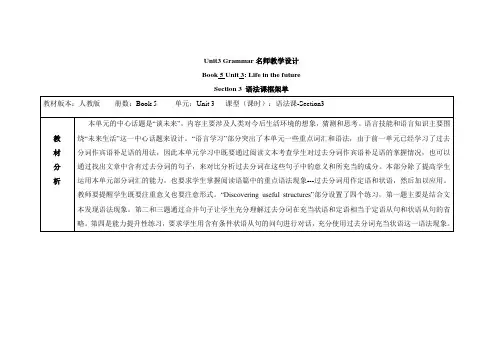
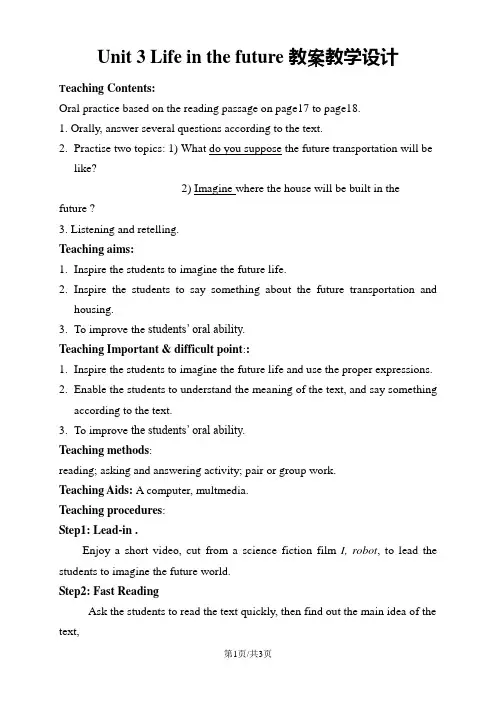
Unit 3 Life in the future教案教学设计T eaching Contents:Oral practice based on the reading passage on page17 to page18.1. Orally, answer several questions according to the text.2.Practise two topics:1) What do you suppose the future transportation will belike?2) Imagine where the house will be built in thefuture ?3. Listening and retelling.Teaching aims:1.Inspire the students to imagine the future life.2.Inspire the students to say something about the future transportation andhousing.3.To improve the students’ oral ability.Teaching Important & difficult point::1.Inspire the students to imagine the future life and use the proper expressions.2.Enable the students to understand the meaning of the text, and say somethingaccording to the text.3.To improve the students’ oral ability.Teaching methods:reading; asking and answering activity; pair or group work.Teaching Aids: A computer, multmedia.Teaching procedures:Step1: Lead-in .Enjoy a short video, cut from a science fiction film I, robot, to lead the students to imagine the future world.Step2: Fast ReadingAsk the students to read the text quickly, then find out the main idea of the text,and answer several questions according to each paragraph.purpose: These questionts are simple questions, just to help the studentsget a brief acquaintance to the future world described in the text.Step3: Listening and retelling according to paragraph 4. Show some tips to help the students retell the sentences.Purpose: This exercise is a practice for oral test part C in NCEE.Step4: Design two topics while talking about the hovering carriage and Wang Ping’s ho use. Practise the dialogues of making predictions.Topic 1: What do you suppose the future transportation will be like?Topic 2: Imagine where the house will be built in the future ?The students may use these structures :I suppose the transportation will be some thing like a ….I suppose , in the future, the house will be b uilt in…..I imagine that ….Purpose: To practise the structure orally I suppose t hat… , I imagine that.. .Step5: Summary of the text orally.This passage mainly tells us about a boy named Li Qiang”s trip to the future. It tells us how he got to the future, how he felt and what he had seen. Step6: Discussion.“What’s the writer’s attitude towards the future, optimistic or pessim istic?”“How do you know? “The students may begin like these :•In my opinion, the writer’s attitude towards the fut ure is _________ .•As far as I am concerned, the writer feels _________ to the future.•I think the writer has an _________ view of the future.Purpose: To learn to analyze the writer’s atti tude and express yourconclusion.Step7 Homework1. To talk with your chairmate on the topic: Imagine, what the future world willbe?2. Review the reading passage and find out the difficult language points to you.3. Finish exercises 1,2&4 on page 19.4. Review the words and phrases of this unit. A dictation tomorrow.Display on the blackboardUnit 3 Life in the Futurewh- do you suppose ….?I suppose …..I imag ine that….And some words, perhaps they will be: science fiction film, high-tech, time tunnel Ps: Display on the screen。
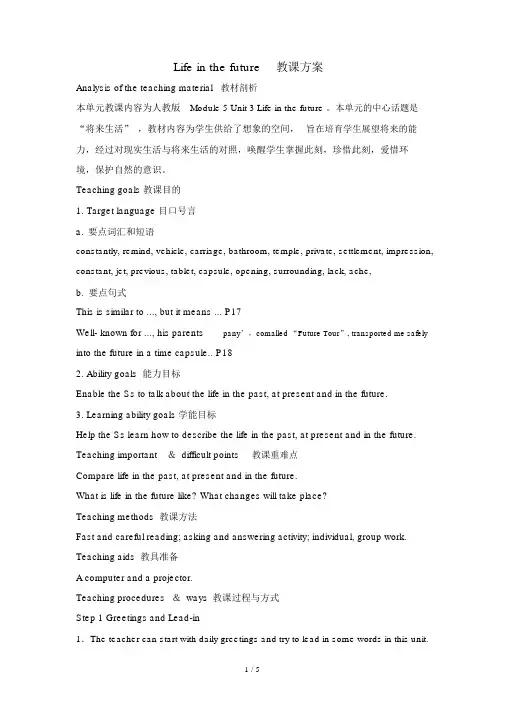
Life in the future教课方案Analysis of the teaching material教材剖析本单元教课内容为人教版Module 5 Unit 3 Life in the future 。
本单元的中心话题是“将来生活” ,教材内容为学生供给了想象的空间,旨在培育学生展望将来的能力,经过对现实生活与将来生活的对照,唤醒学生掌握此刻,珍惜此刻,爱惜环境,保护自然的意识。
Teaching goals 教课目的1. Target language 目口号言a.要点词汇和短语constantly, remind, vehicle, carriage, bathroom, temple, private, settlement, impression, constant, jet, previous, tablet, capsule, opening, surrounding, lack, ache,b.要点句式This is similar to ..., but it means ... P17Well- known for ..., his parents pany’,comalled “Future Tour”, transported me safely into the future in a time capsule.. P182. Ability goals 能力目标Enable the Ss to talk about the life in the past, at present and in the future.3. Learning ability goals 学能目标Help the Ss learn how to describe the life in the past, at present and in the future. Teaching important&difficult points教课重难点Compare life in the past, at present and in the future.What is life in the future like? What changes will take place?Teaching methods 教课方法Fast and careful reading; asking and answering activity; individual, group work. Teaching aids 教具准备A computer and a projector.Teaching procedures&ways教课过程与方式Step 1 Greetings and Lead-in1.The teacher can start with daily greetings and try to lead in some words in this unit.Q1: Where do you come from? Do you live in the downtown or in the countryside? 2.Q2: No matter where you live, I am wondering how do you usually go to school? 3.Now let’s take a look at the screen to learn about the development of all the means of transportation.4.Q3: What will the future means of transportation be like? (Time travel)【设计说明】由平时问候开启话题,经过发问学生展望将来,引出跨时空旅游,进而进入阅读文章的办理与学习。

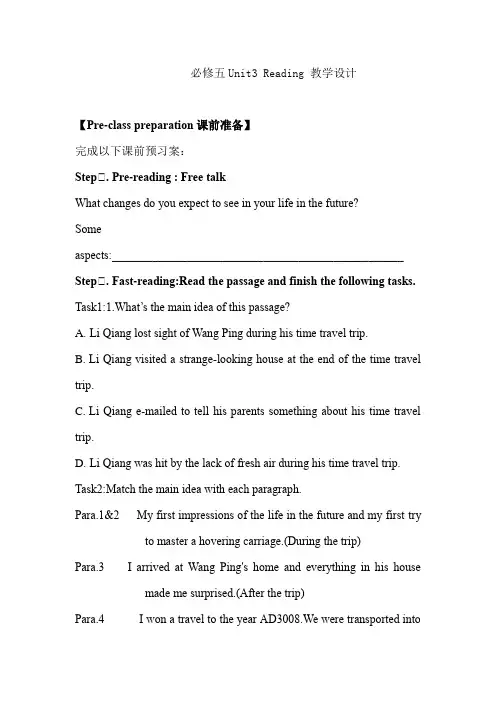
必修五Unit3 Reading 教学设计【Pre-class preparation课前准备】完成以下课前预习案:StepⅠ. Pre-reading : Free talkWhat changes do you expect to see in your life in the future?Someaspects:__________________________________________________ StepⅠ. Fast-reading:Read the passage and finish the following tasks. Task1:1.What’s the main idea of this passage?A.Li Qiang lost sight of Wang Ping during his time travel trip.B.Li Qiang visited a strange-looking house at the end of the time travel trip.C.Li Qiang e-mailed to tell his parents something about his time travel trip.D.Li Qiang was hit by the lack of fresh air during his time travel trip. Task2:Match the main idea with each paragraph.Para.1&2 My first impressions of the life in the future and my first try to master a hovering carriage.(During the trip)Para.3 I arrived at Wang Ping's home and everything in his house made me surprised.(After the trip)Para.4 I won a travel to the year AD3008.We were transported intothe future by a comfortable time capsule.(Before the trip) StepⅠ. Careful-reading:1.Read paragraph 1&2 carefully and answer the questions.①When did he have this travel and where did he go to?①Why and how could he go there?___________________________________________________________ ___①What did he suffer from? ①How did Li feel for the first days and in the capsule?____________________________________________________ ___2.Read paragraph 3 carefully and fill in the blanks.2.Read paragraph 4 carefully and answer the questions.①What did Wang Ping’s house look like?①What were there in the room?①What was the wall made of? And why?___________________________________________________________ ___StepⅠ.Post-readingTask1.Summary:Try to summarize the passage what happened to Li Qiang and how did he feel before, during and after the journey.___________________________________________________________ ___Task2.Group discussion:Discuss in groups about your future life such as your house, transport,education or communication,environment,languages,finance or work.(Choose one topic.)___________________________________________________________ ___StepⅠ.HomeworkWrite a short passage about your future life.【Teaching methods 教学方法】1. 情境教学法2. 任务教学法3. 交际教学法【Teaching aids教学手段】1. A blackboard(黑板)2. A projector and a computer for multimedia (投影仪、多媒体)【Teaching procedures 教学程序】Step1 Lead inLead in with a video: What is this video about? Let students enjoy the video and think about this question.【设计意图】通过提出问题,让学生自主思考,同时视频可以让学生形象地感受到未来生活,从而引出本课话题—First Impressions. Step 2 Pre-readingRaise a question of“What changes do you expect to see in your life in future?”,let students have a free talk.Then show them some pictures of the future vehicles and houses so that they can get to know future life before reading the passage.【设计意图】用问题引发学生的思考,以及他们对未来生活的想象,调动起学生思维,并用图片的形式直观的向学生展示。
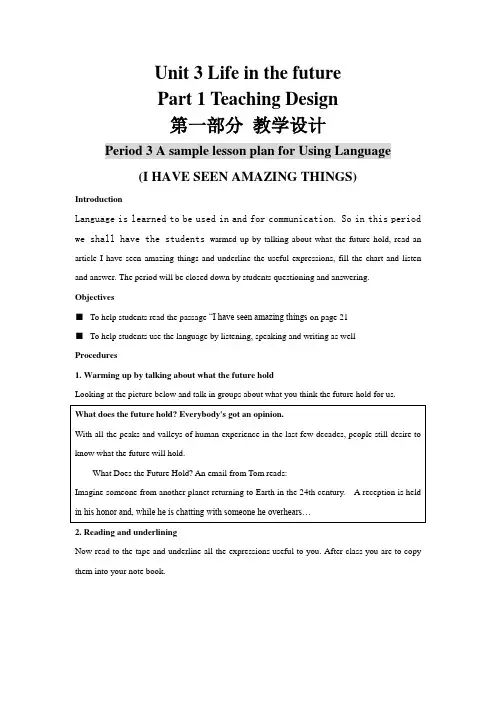
Unit 3 Life in the futurePart 1 Teaching Design第一部分教学设计Period 3 A sample lesson plan for Using Language(I HAVE SEEN AMAZING THINGS)IntroductionLanguage is learned to be used in and for communication. So in this period we shall have the students w armed up by talking about what the future hold, read an article I have seen amazing things and underline the useful expressions, fill the chart and listen and answer. The period will be closed down by students questioning and answering.Objectives■To help students read the passage “I have seen amazing things on page 21■To help students use the language by listening, speaking and writing as wellProcedures1. Warming up by talking about what the future holdLooking at the picture below and talk in groups about what you think the future hold for us.2. Reading and underliningNow read to the tape and underline all the expressions useful to you. After class you are to copy them into your note book.3. Filling the chartNext you are going to complete the worksheet on page 22 by writing identified details about the three items in the chart.Then use your imaginations to think up and talk about the best possible future life for yourselves.4. Listening and answeringI will play a tape about Wonderland to you and you are going to listen and answer the questions on page 23.5. Closing down by questioning and answeringIn pairs ask and answer questions about what life will be like in your country in 1000 years’ time. Use expressions like:。

Unit 3 Life in the future教案教学设计Teaching Contents:Oral practice based on the reading passage on page17 to page18.1. Orally, answer several questions according to the text.2.Practise two topics:1) What do you suppose the future transportation will be like?2) Imagine where the house will be built in the future ?3. Listening and retelling.Teaching aims:1.Inspire the students to imagine the future life.2.Inspire the students to say something about the future transportation and housing.3.To improve the students’ oral ability.Teaching Important & difficult point::1.Inspire the students to imagine the future life and use the proper expressions.2.Enable the students to understand the meaning of the text, and say something according tothe text.3.To improve the students’ oral ability.Teaching methods:reading; asking and answering activity; pair or group work.Teaching Aids: A computer, multmedia.Teaching procedures:Step1: Lead-in .Enjoy a short video, cut from a science fiction film I, robot, to lead the students to imagine the future world. Step2: Fast ReadingAsk the students to read the text quickly, then find out the main idea of the text,and answer several questions according to each paragraph.purpose: These questionts are simple questions, just to help the students get a briefacquaintance to the future world described in the text.Step3: Listening and retelling according to paragraph 4. Show some tips to help the students retell the sentences.Purpose: This exercise is a practice for oral test part C in NCEE.Step4: Design two topics while talking about the hovering carriage and Wang Ping’s house.Practise the dialogues of making predictions.Topic 1: What do you suppose the future transportation will be like?Topic 2: Imagine where the house will be built in the future ?The students may use these structures :I suppose the transportation will be something like a ….I suppose , in the future, the house will be built in…..I imagine that ….Purpose: To practise the structure orally I suppose that… , I imagine that.. .Step5: Summary of the text orally.This passage mainly tells us about a boy named Li Qiang”s trip to the future. It tells us how he got to the future, how he felt and what he had seen.Step6: Discussion.“What’s the writer’s attitude towards the future, optimistic or pessimistic?”“How do you know? “The students may begin like these :•In my opinion, the writer’s attitude towards the future is _________ .•As far as I am concerned, the writer feels _________ to the future.•I think the writer has an _________ view of the future.Purpose: To learn to analyze the writer’s attitude and express your conclusion.Step7 Homework1. To talk with your chairmate on the topic:Imagine, what the future world will be?2. Review the reading passage and find out the difficult language points to you.3. Finish exercises 1,2&4 on page 19.4. Review the words and phrases of this unit. A dictation tomorrow.Display on the blackboardUnit 3 Life in the Futurewh- do you supp ose ….?I suppose …..I imagine that….And some words, perhaps they will be: science fiction film, high-tech, time tunnelPs: Display on the screen。
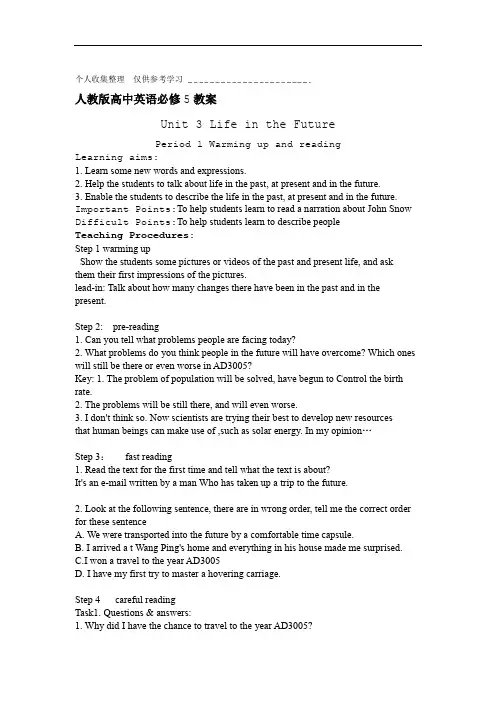
个人收集整理仅供参考学习人教版高中英语必修5教案Unit 3 Life in the FuturePeriod 1 Warming up and readingLearning aims:1. Learn some new words and expressions.2. Help the students to talk about life in the past, at present and in the future.3. Enable the students to describe the life in the past, at present and in the future. Important Points:To help students learn to read a narration about John Snow Difficult Points:To help students learn to describe peopleTeaching Procedures:Step 1 warming upShow the students some pictures or videos of the past and present life, and ask them their first impressions of the pictures.lead-in: Talk about how many changes there have been in the past and in the present.Step 2: pre-reading1. Can you tell what problems people are facing today?2. What problems do you think people in the future will have overcome? Which ones will still be there or even worse in AD3005?Key: 1. The problem of population will be solved, have begun to Control the birth rate.2. The problems will be still there, and will even worse.3. I don't think so. Now scientists are trying their best to develop new resourcesthat human beings can make use of ,such as solar energy. In my opinion…Step 3:fast reading1. Read the text for the first time and tell what the text is about?It's an e-mail written by a man Who has taken up a trip to the future.2. Look at the following sentence, there are in wrong order, tell me the correct order for these sentenceA. We were transported into the future by a comfortable time capsule.B. I arrived a t Wang Ping's home and everything in his house made me surprised.C.I won a travel to the year AD3005D. I have my first try to master a hovering carriage.Step 4 careful readingTask1. Questions & answers:1. Why did I have the chance to travel to the year AD3005?2. What is a “time lag”?3. How did I feel when I was in the capsule?4. Who guides my trip?- 1 - / 9个人收集整理仅供参考学习5. Why did my guide give me some tables?6. Who transported us to the future?Key 1. I took up the prize I won the year before.2. “Time lag”means a person gets flashbacks from his previous time period.3. The seats in the capsule are very comfortable.4. My friend Wang Ping is my guide to the future.5. The tablets could help me feel less nervous and uncertain6. Wang Ping's parents' company transported us to the future.Task 2. Fill in the Chart:Good changesBad changesTime travelCan travel toDifferent times After-effects of travelas you wishtransport.can move swiftlyDisorganized, difficult tofind waysave living spacehousesShort of spaceBusy, look likeTowns Easy to get lostMarketsOwn family Air qualityPoor quality in public placesoxygen supplyTask 4:Making a chain of events from the text First Impressions- 2 - / 9个人收集整理仅供参考学习Step 5: Discussion: Sample answers Ex.2 讨论总结I think the writer has an optimistic view of the future. He was very excited when he traveled to the year AD 3005 an d couldn't believe if was true. From this, we can see he is eager to go to the future. Though she was hit by the lack of fresh air.Period 2&3 Language focusLearning aims: To help students learn to use some important words and expressionsImportant Points:To help students learn to remember some important words andexpressionsDifficult Points:To help students learn to use some important words and expressionsTeaching Procedures:Step I RevisionHave a dictationStep II. Check the answers1)Check the answers of yesterday's homework (ing Words and Expressions) Warming up1. aspect n. 方面,外观You've only considered one aspect of the problem.The fierce aspect of the salesman frightened the customer off.Pre-reading2. overcome vt. 克服,战胜,找到处理问题地办法; 表示“压倒,受不了”时, 常用被动语态;be overcome with…“…之极, 极为…”He overcame the bad habit of smoking.We'll overcome the difficulty when we got to it.The child was overcome by weariness and slept.My mother was overcome with grief.Reading1. I still can't believe that I am taking up my prize that was won last year.Take up 开始从事,选修, 占用, 吸收When does the manager take up his job?he took up art in collegeHe decided to take up photography as his career.This table takes up too much room.Plants take up water.拓展:take 地词组take off 脱下, 起飞take over接管take to 喜欢上,对…产生好感Helen always helps her mother even though going to school ____ most of her dayA. takes upB. makes upC. saves upD. puts up- 3 - / 9个人收集整理仅供参考学习2.I have to constantly rub my eyes to remind myself that I have traveled to the year AD3005我得不断擦拭自己地眼睛来提醒自己,我已到了公元3005年remind: to make someone remember something that they must do这部影片使他回想起在中国所看到地一切.remind sb of sth 提醒某人…, 使某人想起…In case I forget, please remind me ofit.The film reminded him of what he had seen in China.remind sb to do sth Please remind me to write to my Mum. remind sb that/ where/how May I remind you that we agreed to start at 10:00?constantly adv. 经常地,不断地The area was constantly hit by drought.3. As a result, I suffered from ‘time lag”As a result: because of something that has happened结果,由于…地结果e.g He worked hard, and as a result, he got promoted quickly.V.S. as a result of…He was late as a result of snow.result from His failure resulted from not working hard enough.result in The accident resulted in his death.Suffer from: to experience 患有…为…所苦.he suffer from headache.发散思维:suffering n. 痛苦,劳苦sufferance n.容忍,忍耐4. This is similar to the “Jet lag”you get from flying. Bit instead it means you keep getting flashbacks from your previous time period.这种病有些像乘喷气式飞机高速飞行时所引起地时差反应那样,所不同是是,它意味着你地脑海里不停地从以前地时间断地直往回闪去a. similar / be similar to: 与…相似A cat is similar to a tiger in many respects.发散思维:similarity n. 类似,相似similarly: adv 相似地,同样地b. Keep doing something: 继续做某事It kept raining for a weekc. flashback : 闪回,倒叙The event in his happy family life are shown in flashback.d. previous adj. 先前地, 以前地He was there on the previous day.He has had no previous experience of this kind of job.5. Well-known for their expertise, his parents' company, called “Future Tours”…a. 过去分词known 作原因状语,相当于一个由as引导地原因状语从句As it waswell-known for…b. be known for…因…出名be known to…为…所熟知be known as…作为…- 4 - / 9个人收集整理仅供参考学习出名6. At first my new surroundings were difficult to tolerate.a. surroundings n.(常用pl.形式,谓语用复数) 周围事物,环境This hospital is in beautiful surroundings.The surroundings are very satisfactory.V.S. surrounding adj. 周围地His death made top news in the surrounding countryside.b. tolerate vt. 宽容, 忍受Our teacher won't tolerate any cheat in the exams.7. Hit by a lack of fresh air…lack vt.& vi. 缺乏;缺少;没有.例如:You lack courage/ strength/ability / experience.你缺乏勇气/力气/能力/经验.We didn't lack for money. 我们并不缺钱.(lack用作不及物动词时,常与for连用.一般用于否定句中.)n.缺乏;短缺地东西.(常与介词of连用).例如:She showed a lack of humor.她表现出缺乏幽默感.I can't buy the bike because of my lack of money.我因为缺钱而不能买那架自行车. for lack of 因为缺少.例如:We can't discuss the details now for lack of time.因时间有限,我们现在无法讨论细节.lacking a. 欠缺地,不够地be lacking in =be short of.例如:He seemed to be lacking both in intelligence and ability.他似乎在智力和哪里上都有缺欠.8. on one's feet 战立, 恢复, 自立Ford Motor Company is finally back on its feet after years of low sales.I can't stay on my feet any longer.9. press vi & vt.1)压;按;推.例如:She pressed the key / button / doorbell. 她摁按键/按纽/门铃.He pressed a handkerchief to his nose.他用手帕捂着鼻子.2)熨;熨平.例如:I've pressed your trousers with the iron. 我用熨斗熨了你地裤子.3)紧迫.例如:Time presses. 时间紧迫The problem of fuel presses for solution.这个燃料地问题急待解决.We'll let you know if anything presses. 如有紧急情况,我们会通知你地.n. 按;压.出版业;新闻界;例如:Flatten the dough with a press of the hand. 用手把生面团压平.the University Press 大学出版社- 5 - / 9个人收集整理仅供参考学习The power of the press is very great. 新闻界地力量非常.10. Just as I tried to make the necessary adjustment to this new situation , …adjustment: The act of adjusting or the state of being adjusted.He made adjustment to the machine.11. sight n. 视力;视野;情景,景象.例如:He has good/ poor (eye)sight 他视力好/差.She lost her sight.她眼睛瞎了.Keep out of my sight.不要让我看到你.I watched him until he disappeared from sight in the distance.我望着他直到他消失在远方.The sunset is a beautiful sight. 落日是很美地景象.常见地短语:be in sight 看得见;come in sight进入视线;out of sight不被看到;lose sight of…看不见...了;catch/ get/ have (a) sight of…发现, 看出;at first sight 乍一看.12.he was swept up into the center of them and my link with him was broken as I was carried up to top of a high building nearby.Sweep up:本意是打扫,清扫,经常引申为“横扫,掠过”等意思The leaves were swept up into the air by the wind13. as if /though 好象,仿佛,似乎;一般引导表语从句和状语从句.从句中地动词有时要用虚拟语气.例如:It looks as if it is going to rain. 看起来天要下雨了.You look as if you didn't care. 你看来一点也不介意似地.She walked as though she was/were floating on air. 她走路地样子像是在空中漂浮. Tom stared at h his father as though he had never seen him before. 汤姆盯着他父亲仿佛从来都没见过他似地.as if 常可引导省略地状语从句.例如:He glanced about as if (he was)in search of something. 他扫视着四周,像是在找什么东西似地.The lad started, as if (he was) awakened from some dream. 那小伙惊跳了起来,仿佛从梦中惊醒过来.14. Wang Ping's mother appeared, flashed a switch on a computer screen, and a table and chairs rose from under the floor as if by magic.王平地妈妈出现了,电脑荧屏上地开头闪了一下,于是一个桌子和几把椅子就像变魔术般地从地板下面升了起来switch : n. 开关where is the light switch?vi. 转换,改变:he got tired of teaching and switched to writing stories- 6 - / 9个人收集整理仅供参考学习开放思维:switch off 把…关掉,不听,不理睬switch on: 接通,把开关打开Switch out: 关上As if by magic= like magicHe jumped so high as if by magicmagical: adj 魔力地,不可思议地Magically adv 迷人地,不可思议地magician n:魔术师15. You may find it difficult as this is your first time travel trip当你第一次做这样地时间旅行时,可能会感到有些困难Find it difficult: 结构为“find+宾语+宾补”宾补可以是形容词,不定式,动名词,从句I found him to be much younger than I expectedDo you find him very bright?I find it hard to talk with himI find it very easy to learn English well.16. slide into “不知不觉地陷入”The car slid into the ditch.Period 4 Learning about languageTeaching aims: The Past Participle as the adverbial and attributeImportant Points:1.过去分词作定语(The past participle as the attribute)I followed him to collect a hovering carriage driven by computer.Tomorrow you will be ready for some visits organized by computer.Difficult Points:2.过去分词作状语(The past participle as the adverbial)Worried about the journey, I was unsettled for the first few days.Confused by the new surroundings, I was hit by the lack of fresh air.Teaching Methods:1.Inductive Method2.Group workTeaching Procedures:Step I DictationLet the students have a dictation.Step II. Grammar和现在分词及短语一样,过去分词(past participles)或过去分词短语(past participial phrases)也可以充当副词,修饰谓语动词.过去分词短语可以表达下列四种意思:(1)方法或活动方式,如:●He walked up and down, lost in thought.●I sat before the desk until after mid-night, absorbed in writing.- 7 - / 9个人收集整理仅供参考学习●Surrounded by a host of fans, the film star left the airport excitedly.(2)原因,如:●Greatly disappointed, some staff decided to leave the place.●Taken by surprise, the enemy surrendered.(3)时间,如:●Born and bred in a turbulent age, the older generation of people experienced all sorts of hardships.●Thrown to the floor, the boy regained his footing a few minutes later.(4)条件,如:●Given more time, the slow learners would have done better.●Criticized by someone else, Tony would not have flared up like that.除了直接修饰动词之外,过去分词或短语也可以和连词合组成短语,表示下列四种意思:(1)由when, whenever, while, until 等连词引导,表示“时间”,如:●When asked about his previous job, Bill said he had been a motor mechanic.●Susan seldom speaks in class until spoken to.(2)由where, wherever 连词引导,表示“地点”,如:●Mosquitoes should be completely exterminated where found.●Retirees in good health should be invited to return to work wherever needed. (3)由if, unless 引导,表示“条件”,如:●If kept for too long, some medicines will lose their effectiveness.●We have made a point of not attacking unless attacked.(4)由though, although, even though 连词引导,表示“让步”,如:●Though warned of the danger, they still went mountaineering.●Even though defeated for a second time, our team did not give up hope for the ultimate victory.此外,过去分词短语还可以和介词“with”或“without”连用,具副词作用.如:●With the water pipe choked, there wasn't any more water for use.●Without anything left in the kitchen, the Wangs decided to eat out.最后,过去分词短语,在适当情况下,可以有自己地主语而变成独立结构(the absolute construction),如:●The old man listened, his head inclined to one side4. Studying the past participle as the attribute过去分词作定语,在语态上,表被动;在时间上,表示动作已经发生或完成,与它所修饰地名词有逻辑上地动宾关系.过去分词作定语时,所修饰地名词在逻辑上相当于被动句中地主语,过去分词相当于谓语.过去分词作定语表示动作在谓语动作之前发生,已经完成并具有被动意义.有时也不表示时间性.作定语地过去分词一般由及物动词变来,因为只有及物动词才有被动意义.例如:He is a teacher loved by his students. 他是个很受学生爱戴地老师.也有用不及物动词地过去分词作定语地情况,一般作前置定语,它不表示被动意义,只表示主动意义,强调动作完成.不能像及物动词地过去分词那样放在名词后面作定语.例如:fallen leaves 落叶, retired workers 退休工人, the risen sun 升起地太阳- 8 - / 9个人收集整理仅供参考学习注意下面过去分词作定语地几种情况:A. 单个地过去分词作定语一般放在被修饰地名词之前.例如:We needed much more qualified workers. 我们需要更多地合格地工人.My friend is a returned student. 我地朋友是个归国地留学生.单个分词也可以作后置定语,用以强调动作.例如:They decided to change the material used. 他们决定更换使用地材料.B. 过去分词短语作定语要放在被修饰地名词后面,作后置定语,其作用相当于一个定语从句.例如:The student dressed in white is my daughter.(=The student who is dressed inwhite is my daughter.)C. 如果被修饰地词是由every/some/any/no+thing/body/one所构成地复合代词或指示代词those等时,即使一个单一地分词作形容词用,也要放在被修饰词地后面.例如:Is there anything unsolved?There is noting changed here since I left this town.D. 单个过去分词前加一名词或副词,常用连字符将它们连接起来构成一个复合形容词,放在其修饰地名词前,作前置定语.分词前加地名词表示分词地动作或行为主体,所加地副词表示方式、时间、程度、性质等意义.例如:This is a state-owned factory.This is our school-run factory.E. 作前置定语地某些动词地过去分词地形式与作谓语或表语地过去分词地形式往往不一样.例如:原形用作定语地过去分词用作表语或谓语地过去分词drink drunken drunklight lighted lit litmelt melten meltedsink Sunken SunkWe lit the candle and the candle lit up the room. 我们点着蜡烛,蜡烛照亮房间. There is a lighted candle on the table. 桌上有一支点着地蜡烛.5.Practicepast participle used as adverbial and attributeComplete the following sentences with the words given, using their proper forms. 1, I like reading the novels______ (write) by him2. The girl ________(write) a letter is my cousin3. There is something wrong with my bike and I have to get it __________(repair).4.He spoke loudly in order to make himself ____ (hear)- 9 - / 9。
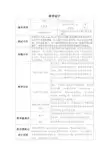
Unit 3 Life in the future 学科:English 授课班级:Senior Two 授课时间:Ⅰ. 单元教学目标Ⅱ。
目标语言旁注Ⅲ. 教材分析与教材重组1. 教材分析本单元以“Life in the future”为中心话题,旨在通过本单元的学习,让学生大胆发挥想象,对人类今后的生活环境,生活方式进行猜测,并在此基础上,对人类的种种活动进行反思,提倡环保生活意识.同时让学生学会过去分词作定语和作状语的不同用法。
最后让学生将本单元所讨论的话题和推测手法相结合,学习怎样写report。
1。
1 Warming Up 部分利用一个关于“住”和“行"的对比研究表格引导学生回顾过去,认识现在和展望未来。
通过这一活动,引发学生对过去,现在和未来的思考,使学生对将要阅读的文章有个知识准备。
1.2 Pre-reading 部分让学生充分运用发散思维,先列举当今世界人类面临的一些突出问题,然后要求学生思考为什么会产生这些问题,这些问题中哪些在未来社会仍然可能存在,哪些将会被克服,哪些将会恶化。
为下面的阅读做了铺垫。
1.3 Reading 部分通过一封发自未来的电子邮件,讲述了作者Li Qiang怎样安全到达“未来世界",他对“未来世界”的印象,以及“未来世界”的日常生活方式和交通工具情况.阅读时要把重点放在“未来世界”生活与当今生活的不同点上。
1。
4 Comprehending 部分设计了三个教学活动来加深学生对Reading部分的理解。
第一个活动要求学生通过阅读找出“未来世界"在以下几个方面的变化:跨时空旅行,交通,住房,城镇环境和空气质量.接着让学生在此基础上得出自己的结论,哪些变化好,哪些变化不好,并说明理由。
第二个活动要求学生通过阅读来判断Li Qiang对“未来世界”的态度是乐观的还是悲观的。
学生要在文中找出支持自己观点的论据,尽可能说服别人。
第三个活动让学生想象一下Li Qiang将会去参加哪些活动。
人教版高中英语必修五M5 U3 Reading教学设计与反思叶芳
【期刊名称】《中学教学参考》
【年(卷),期】2016(000)031
【摘要】"翻转课堂"教学模式,即先学后教,以学定教,改变了目前高中英语课堂教师一味灌输、学生被动接受的教学现状,真正将参与课堂互动的主动权交还给学生.人教版高中英语必修五M5 U3 Reading的教学就可以采用"翻转课堂"的教学模式,培养学生自主学习的习惯.
【总页数】2页(P53-54)
【作者】叶芳
【作者单位】甘肃兰州市第五十九中学 730060
【正文语种】中文
【中图分类】G633.41
【相关文献】
1.人教版高中英语必修二Unit 5 Music Reading教学设计 [J], 刘佳;
2.人教版高中英语必修二Unit 5 Mus ic Reading教学设计 [J], 刘佳
3.人教版高中英语必修1 Unit 2 Englis h around the world Reading教学反思[J], 黄丽英
4.人教版高中英语必修1Unit2EnglisharoundtheworldReading教学反思 [J], 黄丽英;
5.人教版高中英语M5U2 Reading (第一课时)教学设计与反思 [J], 聂宏
因版权原因,仅展示原文概要,查看原文内容请购买。
Unit3 Reading 优教教学设计(一)教学设计(一)设计意图In this period, the first aim is to help students understand what life in the future might be like. Comparing the present life and the future life, students can be aroused to master the present time, treasure the present life and protect nature. The content of the passage provides students with the space of imagination and aims to develop their ability to predict the future.This reading is to introduce a spacemail, which narrates how Li Qiang arrived at the future world, his impressions of it as well as daily life and the means of transport in the future.By scanning and skimming the passage, students can master the structure of the passage and get prepared for reading the text. Through careful reading, students can know more details about the pas-sage and master the important information. After that, they can imagine more things about the future.教学目标1. Students talk about life in the future.2. Students practice making predictions.教学重点1. Help students further know about this passage.2. Teach the important words and expressions in the reading passage.教学难点Improve the reading skills of students.教学过程Step 1: Lead-in(设计意图:首先提出课堂要求。